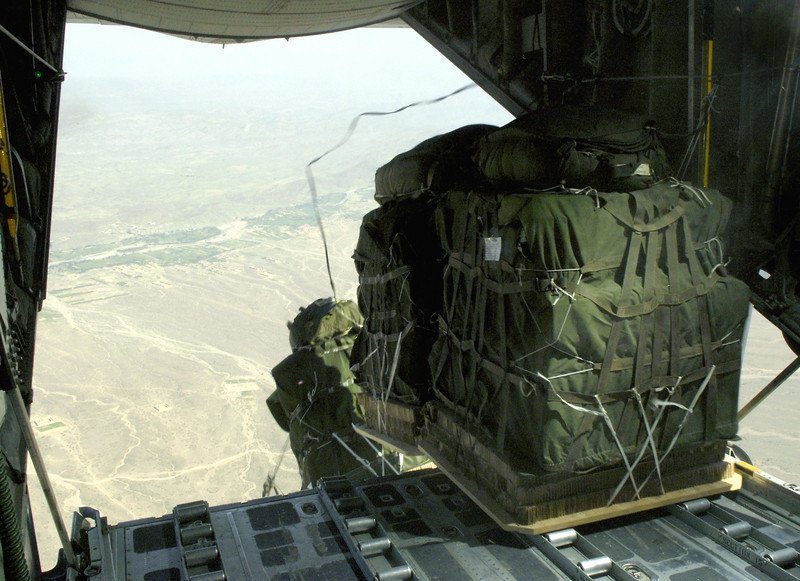Since 2005, when the first forms of the Joint Precision Aerial Delivery System were being developed and used, the idea of a “precision” airdrop has continued to grow and evolve.
During the 2011 International Airdrop Symposium here July 19-21, service members from 26 nations took part in discussions, briefings and demonstrations to learn more about airdrops and the systems used to deliver them — including JPADS and related precision systems.
JPADS is a high-altitude, all-weather capable, global positioning system-guided, precision airdrop system that provides increased control upon release from the aircraft. Traditional airdrops by Air Force airlifters, such as the C-130 Hercules and C-17 Globemaster III, are at altitudes of anywhere between 400 and 1,000 feet. With JPADS, those same airlift aircraft have the potential to guide air drop bundles from as high as 25,000 feet.
Early on in precision airdrops, Air Mobility Command was part of an effort to take the idea of something like JPADS and make it a reality. In November 2005, AMC opened a JPADS “Tiger Team” that included representation from dozens of agencies at command headquarters, including the Combat Operations Division and Plans and Programs and the Air Mobility Warfare Center (now U.S. Air Force Expeditionary Center) at Joint Base McGuire-Dix-Lakehurst, N.J.
By Aug. 31, 2006, the combined team — which included personnel from the Air Mobility Battlelab and the Air Force Mobility Weapons School — was successful. Their work paid off when the first combat airdrop using JPADS took place over Afghanistan.
“That effort put us a day ahead of the goal for combat operability by Sept. 1,” said Lt.Col. Dan DeVoe in a May 2007 news report. DeVoe served as the project officer for JPADS and deployed to Afghanistan in 2006 as part of the mobile training team establishing system operations in theater. DeVoe now works with the 615th Contingency Response Wing at Travis Air Force Base, Calif.
Since that first successful JPADS airdrop nearly five years ago, the types of JPADS versions have grown. JPADS includes a mission planner to plan the optimal release points using special software residing on a laptop computer. The computer is loaded with a high-resolution grid of forecasted winds. The mission planner also receives updated near real-time wind speeds while in the air using hand-launched dropsondes (hand-sized, parachute-equipped wind indicators). When dropped, GPS receivers on the airdrop bundles use the steering mechanisms to “fly” the bundles to their predetermined drop zones.
Richard Benney, from the U.S. Army Natick Soldier Research, Development and Engineering Center, or NSRDEC, at Natick, Mass., discussed JPADS during the airdrop symposium. On JPADS he said, “We can break it into multiple weight versions.”
According to DeVoe, the first JPADS airdrop was “in the 2,000-pound range.” Benney said there are JPADS versions now in five categories: micro-light, 10 to 150 pounds; ultra-light, 250 to 700 pounds; extra-light, 700 to 2,400 pounds; light-version, 5,001 to 10,000 pounds; and medium version, 10,001 to 42,000 pounds.
All of the versions are part of a team effort with the Army, Air Force and other joint and coalition partners, Benney said. The ultra-light version testing and use is being led by the Marine Corps.
“Precision airdrops have been a part of our increasing level of airdrops we’ve done in Afghanistan,” said Lt. Col. David Mackenzie, deputy director for U.S. Air Forces Africa’s Plans and Requirements Directorate at Ramstein Air Base, Germany. He was at the symposium with international representatives from five African nations.
“Because Afghanistan has brought the precision airdrop into the arena, other nations who are building an airdrop capability want to know more about how it works,” Mackenzie said.
Half-way through 2011, mobility Airmen performing airdrops in Afghanistan are on a record pace having airdropped more than 39.5 million pounds of cargo as of June 30, Air Forces Central statistics show. In 2006, the year of the first JPADS airdrop, only 3.5 million pounds was airdropped for the entire year.
Through the symposium the cooperation and understanding for airdrops, and precision airdrops in particular, is a growing enterprise.
“Precision airdrop is a rapidly advancing capability in operations around the world,” Benney said. “Interest in the capability is growing.”
In 2007, then-commander of the AMWC, Maj. Gen. Scott Gray, may have said it best about why “precision” airdrops are important.
“This is a revolution in the way air mobility supports the warfighter,” Gray said. “We want to save lives…this will help us get there.”










